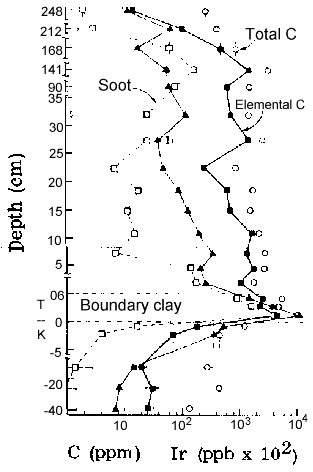 |
Science Frontiers ONLINE No. 60: Nov-Dec 1988 |
|
|
Global fire at the k-t boundary
The worldwide deposit of iridium at the K-T (Cretaceous-Tertiary) boundary has been considered very strong evidence that a large astronomical object (asteroid or comet) devastated our planet some 65 million years ago. Some scientists, however, propose that the iridium layer was instead deposited through widespread volcanic activity. The proponents of an astronomical mechanism should be heartened by a recent paper in Nature, by W.S. Wolbach et al. Here is their Abstract:
"Cretaceous-Tertiary (K-T) boundary clays from five sites in Europe and New Zealand are 102 -104 -fold enriched in elemental C (mainly soot), which is isotopically uniform and apparently comes from a single global fire. The soot layer coincides with the Ir layer, suggesting that the fire was triggered by meteorite impact and began before the ejecta had settled."
The composition of the hydrocarbons in the sediments points to the earth's biomass (mainly surface vegetation) as the source of the soot. The total quantity of K-T soot is equivalent to that which would be produced by burning 10% of all present terrestrial plant material.
(Wolbach, Wendy S., et al; "Global Fire at the Cretaceous-Tertiary Boundary," Nature, 334:665, 1988.)
Comment. Unmentioned in the above article is the possibility that extensive wildfires might have been generated by volcanic eruptions, perhaps accompanied by great electrical storms. The 1988 fires in Yellowstone needed no meteoric impact.
Reference. Chemical anomalies in the earth's crust are cataloged in ESC1 in Anomalies in Geology. To order this catalog volume, visit: here.
 |
Concentration "spikes" of iridium, elemental carbon and soot at the KT boundary, Woodside Creek, New Zealand. (Adapated from Nature, 334:665, 1988). |